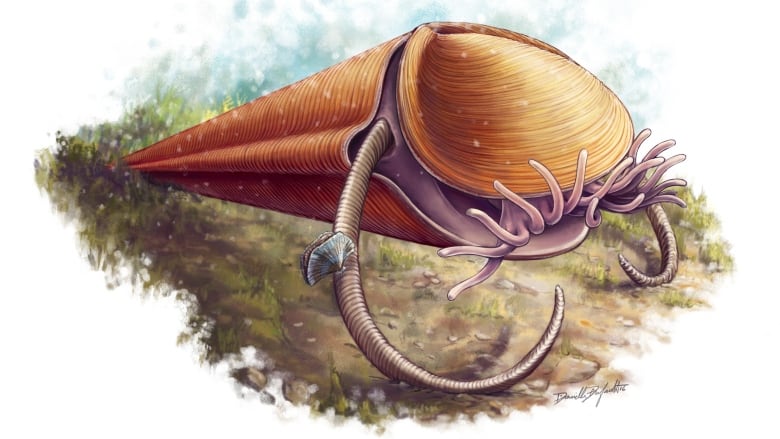Cone-shaped sea creatures finally get place on evolutionary tree
Researchers from the University of Toronto and the Royal Ontario Museum contribute to breakthrough

It looks like an alien creature: a critterwith acone-shaped shell, long arms and tentaclesfluttering out of its fleshy opening. It's not from another world, but an ancient one.
However, until now, hyoliths didn't have a place on Earth's tree of life.
The marine creatures that were mere centimetres long were discovered about 175 years ago. Though many fossils exist around the world,scientists couldn't gather much data from what they found, leaving this ancient creature dangling without a place on the evolutionary tree.
In 2014, a team of Canadian scientists led by 20-year-old University of Toronto undergraduate student Joseph Moysiuk,found ahyolithfossil in Marble Canyon, part of the fossil-rich Burgess Shale in British Columbia. This was a valuable acquisition: it contained the soft tissue of the critter that roamed the Earth 530 million years ago.

For years, scientists believed thathyolithswere related to the same family as snails andmollusks, rather than a group called brachiopods.
"What little we did know, from the shells,just wasn't enough to establish where these things fit on the tree of life," Moysiuk told CBC News. "Brachiopods and clams without their soft tissues might actually look quite similar, even though they belong to totally different branches. It's just a question of not having enough information."
But the soft tissue collected by co-authors of the studythat appears in Nature Martin Smith of Durham University in the United Kingdom and Jean-Bernard Caronfrom the Royal Ontario Museum provided them with very important information.
"Our new preserved soft tissue discovery that we found at the Burgess Shaleinclude this band of tentacles around the mouth, a feeding structure. And this feedingstructure allows us to link the hyoliths with brachiopods."
The hyolith finally had a home.
Differences
When we think of hard-shelled marine animals, we might envisionmussels and clams. These bivalve mollusks are separated by left and right shells. However, with brachiopods, the soft body exists between enclosed upper and lower shells.
- Amazing fossils found by ordinary people thrill scientists
- A new theory about the ancient fossils at Mistaken Point
There are other differences as well, Moysiuk said.
"Like other organisms, including us, clams and brachiopods have a plane of symmetry down the middle of their body. In brachiopods, that planeof symmetry runs through the middle of both shells. In other words, the two sides of the shells are symmetrical with each other. In clams, the two shells are separated by each other by a plane of symmetry. So the two shells are identical to each other but the shells themselves don't have a plane of symmetry within them."

As for the two protrusions on either side of the shells calledhelens though they've been known for some time, scientists were unable to determine their function.
"There is no equivalent to these structures in any other group of organisms," Moysiuk said.
The researchers studied the angles at which the helens were preserved and concluded that hyoliths may have been able to rotate them into a position below the body, propping it up, allowing it to feed, with the tentacles straining particles out of the water.
New piece to puzzle
"Our study adds a new piece to the puzzle, in trying to unravel the story of the tree of life," Moysiuk said.
The hyolith now exists in the grouplophophoratain-between two modern groups of organisms, thebrachiopods and phoronid worms (known as horseshoe worms). While the worms don't have shells, they do have a similarly elongated body like the hyolith.
"It's been very exciting,"Moysiuksaid. "It's so significant for our understanding for the early evolution of animals."












_(720p).jpg)


 OFFICIAL HD MUSIC VIDEO.jpg)
.jpg)



























































































